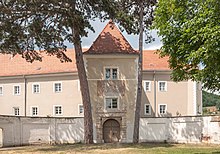Lankowitz Castle
The Lankowitz castle is in the market town of Maria Lankowitz in voitsberg district in West Styria ( Austria ). The origins of the castle go back to the middle of the 15th century. Among other things, it contained a branch of the Graz-Karlau prison , which is now in the buildings of the Lankowitz forest district, and is privately owned. The castle has housed a local museum since 1998.
Location
The castle is located within the local area of Maria Lankowitz at Puchbacherstraße 71-72 on a gravel terrace south of the parish church .
history
Emperor Otto III. gave land to the margrave Adalbero von Eppenstein in the year 1000 in the area of today's municipality of Maria Lankowitz. Adalbero probably commissioned one of his ministerials to build a weir system on the Franziskanerkogel , the so-called Primaresburg . The Primaresburg came from the Eppenstein to the Lords of Wildon , who let the Lords of Graden , their followers, administer the rule . Since the Wildoner took part in a feud against Duke Albrecht I , they lost the rule of Lankowitz, which came to the sovereigns. Around that time, Primaresburg was probably destroyed by fire, and the Gradners built a new, small residence below the Franziskanerkogel.
In 1415, Prince Duke Ernst der Eiserne gave the two brothers Alexander and Peter Gradner permission to build a residence above the village of Lankowitz . It was not until 1440 that Georg Gradner made use of this permit and began building what is now the castle on a property that was a fiefdom of the Counts of Montfort . In 1459 Gradner sold the "Geslos" together with the associated hunting grounds to Emperor Friedrich III. The emperor replaced the feudal sovereignty of Count Hermann von Montfort and enfeoffed Andreas von Greißenegg with the rule of Lankowitz in 1460 . As he was involved in the Baumkircher feud directed against the emperor , he was executed in 1471, and all his property was confiscated from the emperor. Friedrich III. first pledged the Lankowitz property to Thoman Rottaler and in 1479 to Wolfgang Lembacher, before it was leased to him by Hans Geumann in 1491. On the orders of Emperor Maximilian I, Geumann had to hand over the rule to Jörg von Herberstein in 1500, who received it as a pledge. In 1590, Friedrich Freiherr von Herberstein took over Lankowitz Castle as his own in return for a waiver of the pledge . Among the Herberstein castle was probably a moated castle expanded and renovated. Christof Moritz Freiherr von Herberstein exchanged the rule of Lankowitz for Vasoldsberg with the Stainz monastery in 1634 .
The Stainz Abbey merged Lankowitz with Gut Leonroth , with Lankowitz Castle serving as the administrative seat. In 1671 there was a witch trial at the Lankowitz Regional Court, in the course of which all five accused were executed. When Emperor Joseph II had the Stainzer Stift dissolved, Lankowitz was made a state ruler in 1782. In 1848 the palace building was converted into a penal and reformatory institution and was most recently a women's prison and branch of the Graz-Karlau prison . After the prison was closed, the castle went into private ownership and was revitalized in 1993, with the interior divided into apartments and offices. A local museum has been set up in the former castle chapel since 1998, and exhibitions and events are occasionally held in the castle.
lock
The castle is a three-storey, regular four-wing building with a rectangular floor plan, which in its current form dates from the 16th and 17th centuries. The four wings enclose a large columned arcade courtyard , the arches of which have been partially walled up, but have recently been exposed again. A small roof turret rises above the entrance front, which serves as a clock and bell tower. The arched , rusticated main gate is located on a square tower, which protrudes uniaxially from the castle building. The coats of arms of the former owners and a sundial are placed above the main gate. The former palace chapel is decorated with frescoes and has a princely gallery .
Up to the end of the 17th century the castle was a fortified complex, which was surrounded by a wide moat , over which a drawbridge and from the 16th century a wooden bridge led. The defensive wall behind the moat was reinforced with round towers , while in front of the moat there was a sloping glacis . On the other side of the glacis there was a large farm building with a horseshoe-shaped floor plan and the one-story administrator's house. Of the defensive wall, the moat and two projecting towers at the corners of the eastern castle wall, nothing has survived to this day.
literature
- Federal Monuments Office (ed.): Dehio Steiermark (excluding Graz) . 2nd Edition. Berger, Horn / Vienna 2006, ISBN 3-85028-439-5 , p. 281 .
Web links
- Entry via Schloss Lankowitz to Burgen-Austria
Individual evidence
- ↑ a b c d e f g Entry about Lankowitz Castle on Burgen-Austria
- ↑ a b Federal Monuments Office (ed.): Dehio Steiermark (excluding Graz) . 2nd Edition. Berger, Horn / Vienna 2006, ISBN 3-85028-439-5 , p. 281 .
Coordinates: 47 ° 3 '44.1 " N , 15 ° 3' 50.5" E


